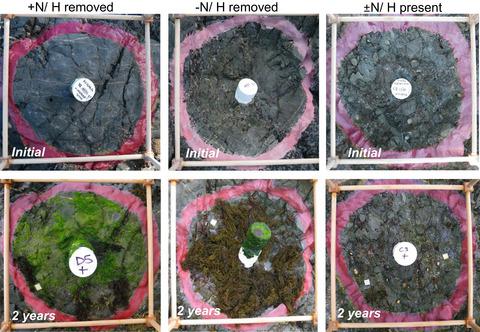Our official English website, www.x-mol.net, welcomes your
feedback! (Note: you will need to create a separate account there.)
Environmental context shapes the long‐term role of nutrients in driving producer community trajectories in a top–down dominated marine ecosystem
Journal of Ecology ( IF 5.3 ) Pub Date : 2020-04-17 , DOI: 10.1111/1365-2745.13405 Rachel J. Clausing 1 , Nicole E. Phillips 2 , Peggy Fong 1
中文翻译:

在自上而下主导的海洋生态系统中,环境因素决定了养分在驱动生产者社区轨迹方面的长期作用
更新日期:2020-04-17
Journal of Ecology ( IF 5.3 ) Pub Date : 2020-04-17 , DOI: 10.1111/1365-2745.13405 Rachel J. Clausing 1 , Nicole E. Phillips 2 , Peggy Fong 1
Affiliation

|
- Two predominant anthropogenic impacts on ecosystems, nutrient enrichment and the removal of consumers, are predicted to interact in their effects on producer diversity. Yet, measures of diversity alone may not capture changes occurring in the underlying mechanisms structuring communities. Furthermore, evidence for these interactions in rocky intertidal systems is mixed and may be confounded by variable baseline productivity or short experimental durations that do not capture seasonality, environmental heterogeneity or successional processes.
- We conducted a 2‐year experiment examining the main and interactive effects of nutrients and herbivores in a low‐productivity environment on the northern shore of Cook Strait near Wellington, New Zealand. We explicitly accounted for the small‐scale spatial environmental heterogeneity characteristic of rocky shores.
- Rapid and dramatic shifts in diversity metrics and cover of algal communities in the first year were driven by removal of herbivores. Within 2 months of herbivore exclusion, open space decreased from >90% to <15%, regardless of nutrient addition, and both algal diversity and evenness plummeted while species richness rose.
- In contrast to theoretical predictions, strong interactions between top–down and bottom–up forces on diversity were rare; rather, over time, the addition of nutrients negatively impacted diversity. Further, where herbivores were removed, nutrients inhibited succession beyond ephemeral forms, contrasting with the tolerance model of succession observed under ambient nutrients.
- The effects of nutrients were only elucidated by accounting for variation in habitat complexity and seasonality, demonstrating that environmental heterogeneity can mask bottom–up processes. Moreover, shifts in relative species abundances revealed that after 10 months, nutrient addition caused increased community turnover regardless of herbivore presence or absence, indicating reduced stability not apparent in simple measures of diversity.
- Synthesis. Our results suggest that nutrient addition and herbivore reduction exert strong but mostly independent control on community biodiversity, where context dependency in habitat complexity, seasonality and successional stage played key roles in determining community outcomes. These findings demonstrate the importance of longer‐term field studies incorporating environmental context and multiple metrics of diversity to reveal the mechanisms underlying effects of nutrient enrichment and herbivore loss on producer community structure.
中文翻译:

在自上而下主导的海洋生态系统中,环境因素决定了养分在驱动生产者社区轨迹方面的长期作用
- 预计对生态系统的两个主要的人为影响,即营养富集和去除消费者,将在其对生产者多样性的影响中相互作用。但是,仅凭多样性衡量可能无法捕获构成社区的基本机制中发生的变化。此外,岩石潮间带系统中这些相互作用的证据是混杂的,并且可能因基线生产力变化或实验时间短而无法捕捉季节性,环境异质性或演替过程而混淆。
- 我们进行了为期两年的实验,研究了新西兰惠灵顿附近库克海峡北岸低生产力环境中养分和食草动物的主要相互作用和交互作用。我们明确考虑了岩质海岸的小规模空间环境异质性特征。
- 第一年,食草动物的去除推动了多样性指标和藻类群落覆盖面的迅速而戏剧性的变化。在草食动物被排斥的两个月内,无论添加何种营养素,开放空间均从> 90%下降至<15%,藻类多样性和均匀性均下降,而物种丰富度上升。
- 与理论预测相反,自上而下和自下而上对多样性的作用之间的相互作用很少。相反,随着时间的流逝,养分的添加会对多样性产生负面影响。此外,在去除草食动物的地方,养分抑制了除短暂形式之外的演替,这与在环境养分下观察到的演替耐受模型相反。
- 仅通过考虑栖息地复杂性和季节性变化来阐明养分的影响,表明环境异质性可以掩盖自下而上的过程。此外,相对物种丰度的变化表明,在10个月后,无论是否存在草食动物,养分的添加都会导致群落更新增加,这表明稳定性的降低在简单的多样性测量中并不明显。
- 综合。我们的结果表明,养分的添加和草食动物的减少对社区生物多样性具有强大但主要是独立的控制作用,其中栖息地复杂性,季节性和演替阶段的背景依赖性在决定社区成果方面起着关键作用。这些发现证明了长期田间研究的重要性,该研究结合了环境背景和多样性的多种指标,以揭示养分富集和草食动物流失对生产者社区结构的潜在影响机制。











































 京公网安备 11010802027423号
京公网安备 11010802027423号